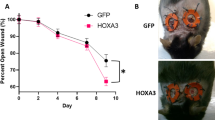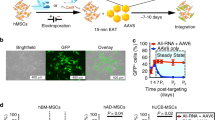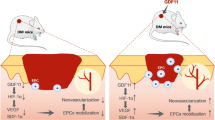Abstract
We recently demonstrated that electroporation enhances transfection in a mouse wound-healing model. Keratinocyte growth factor (KGF) is an inducer of epithelial cell proliferation and differentiation and has been shown to be under expressed in the wounds of diabetic individuals. We hypothesized that KGF delivered into an excisional wound via naked DNA injection with subsequent electroporation would be a novel and potentially effective method to enhance wound closure in a diabetic mouse model. ELISA assays confirmed production of KGF protein in cultured mouse cells and RT-PCR assays confirmed KGF mRNA in skin samples taken from mice. In all, 32 genetically diabetic mice were given two identical excisional wounds of their dorsum and split into two groups with one group receiving KGF DNA injection and electroporation with the other group receiving no treatment. Over 90% of wounds healed in the presence of KGF and electroporation versus 40% in the untreated group by day 12. Histological analysis of the wounds demonstrated that untreated wounds contained microulcers with thin or incomplete epithelium with unresolved inflammation as compared to treated wounds where intact and mature epithelium was observed. Taken together these findings suggest that a single injection of KGF DNA encoded on a plasmid coupled with electroporation improves and accelerates wound closure in a delayed wound-healing model.
This is a preview of subscription content, access via your institution
Access options
Subscribe to this journal
Receive 12 print issues and online access
$259.00 per year
only $21.58 per issue
Buy this article
- Purchase on Springer Link
- Instant access to full article PDF
Prices may be subject to local taxes which are calculated during checkout







Similar content being viewed by others
References
Cohen S . Isolation of a mouse submaxillary gland protein accelerating incisor eruption and eyelid opening in the new-born animal. J Biol Chem 1962; 237: 1555–1562.
Weltman JK . The 1986 Nobel Prize for Physiology or Medicine awarded for discovery of growth factors: Rita Levi-Montalcini, MD, and Stanley Cohen, PhD. N Engl Reg Allergy Proc 1987; 8: 47–48.
Martin P . Wound healing – aiming for perfect skin regeneration. Science 1997; 276: 75–81.
Rubin JS et al. Keratinocyte growth factor. Cell Biol Int 1995; 19: 399–412.
Smola H, Thiekotter G, Fusenig NE . Mutual induction of growth factor gene expression by epidermal–dermal cell interaction. J Cell Biol 1993; 122: 417–429.
Jeschke MG et al. Non-viral liposomal keratinocyte growth factor (KGF) cDNA gene transfer improves dermal and epidermal regeneration through stimulation of epithelial and mesenchymal factors. Gene Therapy 2002; 9: 1065–1074.
Ortho-McNeil . Prescribing information for Regranex Gel, 1999.
Sun L et al. Transfection with aFGF cDNA improves wound healing. J Invest Dermatol 1997; 108: 313–318.
Steed DL . Modifying the wound healing response with exogenous growth factors. Clin Plast Surg 1998; 25: 397–405.
Byrnes CK et al. Success and limitations of a naked plasmid transfection protocol for keratinocyte growth factor-1 to enhance cutaneous wound healing. Wound Repair Regen 2001; 9: 341–346.
Chesnoy S, Lee P-Y, Huang L . Intradermal injection of transforming growth factor-β1 gene enhances wound healing in genetically diabetic mice. Pharm Res 2003; 20: 345–350.
Andree C et al. In vivo transfer and expression of a human epidermal growth factor gene accelerates wound repair. Proc Natl Acad Sci USA 1994; 91: 12188–12192.
Davidson JM, Krieg T, Eming SA . Particle-mediated gene therapy of wounds. Wound Repair Regen 2000; 8: 452–459.
Williams RS et al. Introduction of foreign genes into tissues of living mice by DNA-coated microprojectiles. Proc Natl Acad Sci USA 191; 88: 2726–2730.
Thomas CE, Ehrhardt A, Kay MA . Progress and problems with the use of viral vectors for gene therapy. Nature 2003; 4: 346–358.
Drabick JJ, Glasspool-Malone J, King A, Malone RW . Cutaneous transfection and immune responses to intradermal nucleic acid vaccination are significantly enhanced by in vivo electropermeabilization. Mol Ther 2001; 3: 249–255.
Byrnes CK et al. Electroporation enhances transfection efficiency in murine cutaneous wounds. Wound Repair Regen 2004; 12: 397–403.
Werner S et al. Induction of keratinocyte growth factor expression is reduced and delayed during wound healing in the genetically diabetic mouse. J Invest Dermatol 1994; 103: 469–473.
Greenhalgh DG . Wound healing and diabetes mellitus. Clin Plast Surg 2003; 30: 37–45.
Loots MAM et al. Differences in cellular infiltrate and extracellular matrix of chronic diabetic and venous ulcer versus acute wounds. J Invest Dermatol 1998; 111: 850–857.
Skerrett PJ . Growth factors in the clinic: slow going. Science 1991; 252: 1065.
Chesnoy S, Huang L . Enhanced cutaneous gene delivery following intradermal injection of naked DNA in a high ionic strength solution. Mol Ther 2002; 5: 57–62.
Acknowledgements
Funding for this project was provided by the American Diabetes Assn. 7-02-RA-31, USAMRMC DAMD17-03-1-0029, and the Maryland State Firefighters Fund.
Author information
Authors and Affiliations
Rights and permissions
About this article
Cite this article
Marti, G., Ferguson, M., Wang, J. et al. Electroporative transfection with KGF-1 DNA improves wound healing in a diabetic mouse model. Gene Ther 11, 1780–1785 (2004). https://doi.org/10.1038/sj.gt.3302383
Received:
Accepted:
Published:
Issue Date:
DOI: https://doi.org/10.1038/sj.gt.3302383
Keywords
This article is cited by
-
Supraphysiological testosterone supplementation improves granulation tissue maturation through angiogenesis in the early phase of a cutaneous wound healing model in rats
Inflammation Research (2022)
-
KGF Phage Model Peptide Accelerates Cutaneous Wound Healing in a Diabetic Rat Model
International Journal of Peptide Research and Therapeutics (2021)
-
Improved Specificity of Gene Electrotransfer to Skin Using pDNA Under the Control of Collagen Tissue-Specific Promoter
The Journal of Membrane Biology (2015)
-
Strengthening the Skin with Topical Delivery of Keratinocyte Growth Factor-1 Using a Novel DNA Plasmid
Molecular Therapy (2014)
-
Skin Electroporation of a Plasmid Encoding hCAP-18/LL-37 Host Defense Peptide Promotes Wound Healing
Molecular Therapy (2014)



